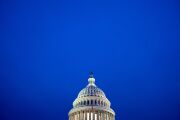Big, occasionally gargantuan, retirement plans are walking the plank in Democrats’ plans to raise taxes. So are millions of far more modest IRAs.
The emerging tax bill would ban individual retirement accounts of all types and any size from holding alternative investments intended only for investors whom securities regulators consider “sophisticated.” That means shares in anything other than publicly-traded stock, bonds or mutual funds — such as private businesses, startups, private equity-backed firms, real estate, hedge funds and peer-to-peer lending networks.
President Joe Biden has promised not to raise taxes on Americans making less than $400,000 a year. The pledge is part of his

But tax writers’ proposal to ban alternative assets in IRAs “would essentially create a wealth tax on millions of middle-income Americans,” said Eric Satz, the founder and CEO of Nashville, Tennessee-based Alto Solutions, a digital service for self-directed IRAs that lets people invest their retirement plans in alternative assets. Unlike a traditional IRA, a self-directed IRA lets its owner invest in alternative assets.
Under an SEC rule that equates wealth with enlightenment, only investors who are “financially sophisticated” are a so-called
Retirement account ‘poison’
Under the House tax bill, investors would be
That latter outcome could create what retirement expert Ed Slott called a “poison” that could translate into
“This net was created to catch big fish like Peter Thiel, but the net catches the smaller fish,” Slott said.
The Thiel effect
Most people aren’t Peter Thiel. But advisors say that like the Silicon Valley behemoth, many solidly middle-income and high middle income people own alternative investments in their IRAs, such as a stake in a single-family rental home located close to where they live.
The difference: While their net worth on paper might be $1 million, their annual income can be a far more modest $150,000 or so — well below Biden’s $400,000 threshold. Meanwhile, advisors say, other retirement savers make a notch over the $200,000 accredited investor limit but don’t have a seven-figure net worth. Or they once earned that much money but don’t any more, and also don’t have a $1 million net worth that doesn’t include their home.
Satz said that there are “millions of accredited investors who make more than $200,000 but less than $400,000 who invest in alternative assets.” A 2016 Government Accountability Office report said there were
Because unconventional assets aren’t publicly traded, they’re often hard to value and more difficult to sell, particularly on short notice. Satz said the tax proposal would “force liquidations on a massive scale of illiquid investments, and this will hurt not just the investors but the companies.”
‘Wealth tax on middle Americans’
The threat to IRAs held by investors of relatively modest means is overshadowed by the tax bill’s
In what might be dubbed the Thiel rule, the
Thiel’s account became huge because the low-value stock it initially held exploded in value. But there are other ways to accumulate a sizable IRA, and the House bill aims to stop them.
One method involves
Another strategy involves 401(ks) retirement plans. An investor takes advantage of a benefit that allows her to put as much as $
The bill effectively nukes Roth strategies for all earners over time. Come 2022, it would ban after-tax contributions in 401(k)s and IRAs contributions from being converted to a Roth regardless of the person’s income level.
Later, come 2032, the bill would prohibit people with income over $400,000 ($450,000 for couples) from converting any IRA to a Roth. That would put an end to so-called “backdoor” Roth conversions, which is when a high earner sidesteps — that’s the backdoor part – the income limits for a Roth plan by morphing a traditional IRA into its Roth cousin. The investor pays taxes, at ordinary rates, on the amount converted, but the pot’s subsequent gains are tax free.
In a backdoor deal, the investor opens up a traditional IRA and funds it with after-tax dollars that are then invested in stocks or other assets. Because the plan is not an employer one, the money kicked in is by definition dollars on which taxes have already been paid. Then the investor converts the traditional plan to a Roth. There’s no tax bill on the conversion, because the taxes have already been paid. Unlike for Roth IRAs, there are no income limits for contributions to traditional IRAs. Slott called the ban on regular conversions, not backdoor ones, “a bigger deal — that’s where the money is” for most investors.
'Not millionaires'
But it’s the bill’s separate aim at investors who use their IRA to put money into alternative assets that has many advisors upset.
Henry Yoshida is the co-founder and CEO of RocketDollar, a company in Austin, Texas, that enables investors to set up self-directed IRAs and solo 401(k)s.
He said that most of his clients are middle-aged, mid-career people who amassed six-figure 401(k)s through their employers and rolled those plans into an IRA. They typically put anywhere from 5% to one quarter of their IRA into alternative investments, like early-stage companies, private businesses, single-family rental homes and cryptocurrency funds.
If the ban on alternative investments becomes reality, “It’s going to curtail the ability of savers who aren’t millionaires or billionaires,” said Yoshida, a CFP who co-founded robo-advisor
Referring to reports in 2012 that former presidential candidate
The IRS defines an IRA as large if it’s worth
“They’ve taken a paint brush the size of Texas,” Satz said, “to an island in the Pacific, and hit millions of people elsewhere.”










